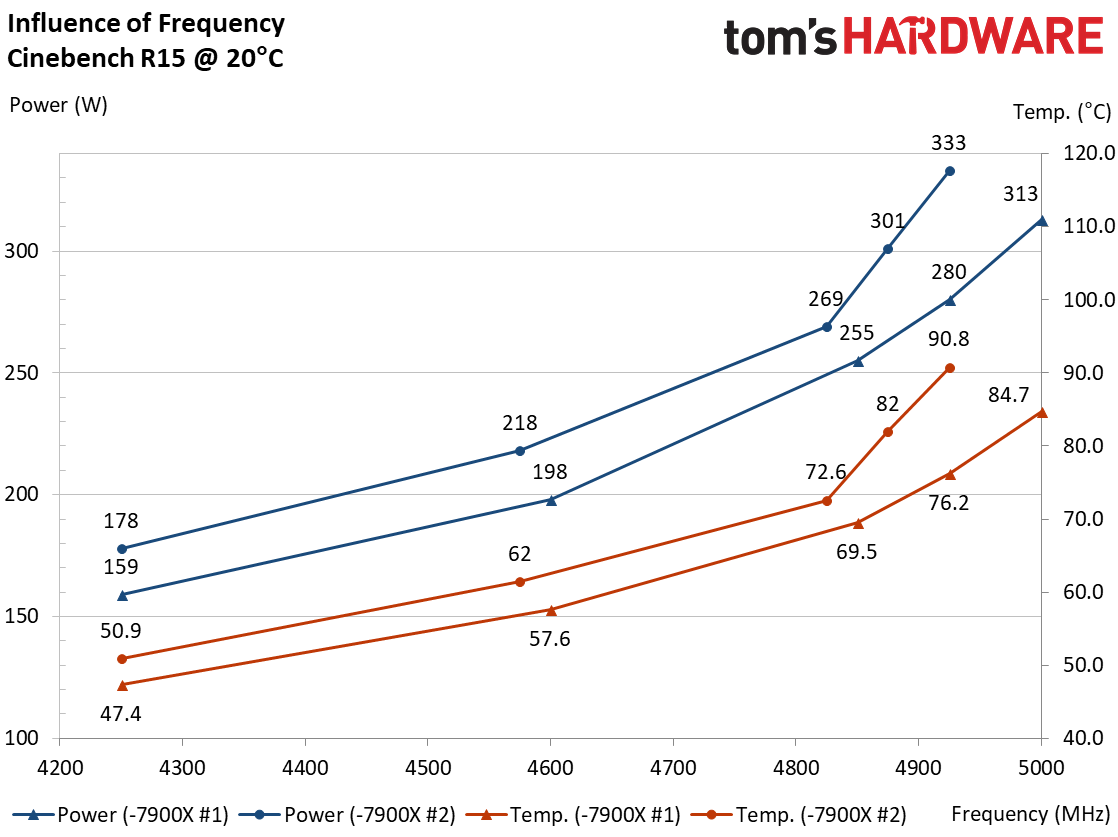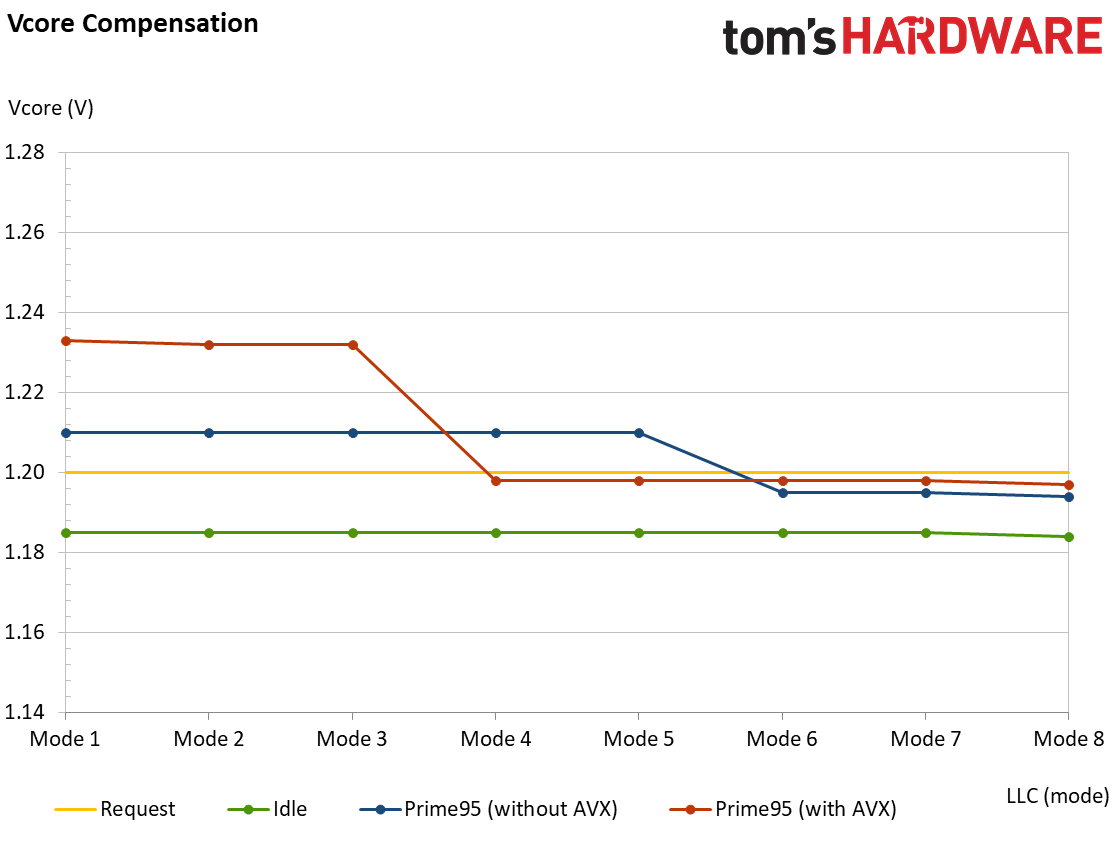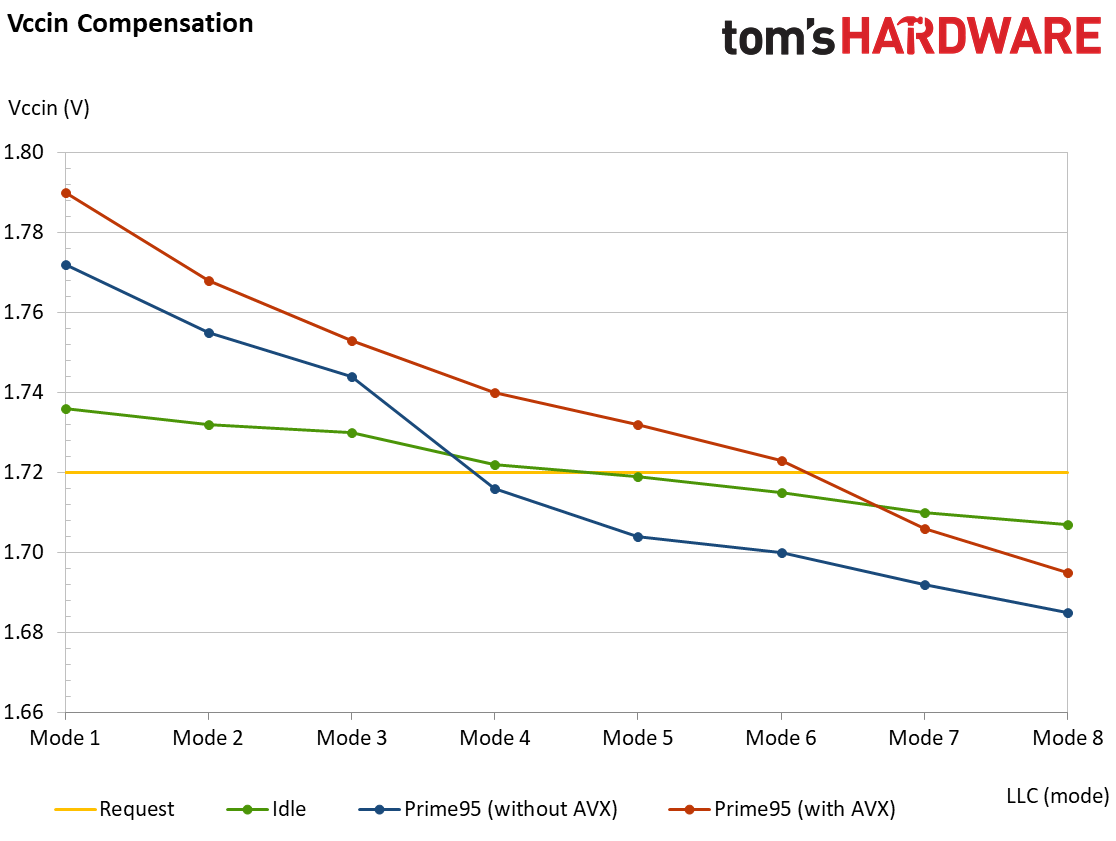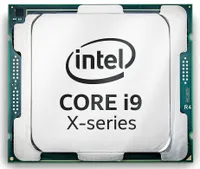Overclocking Intel's Core i9-7900X CPU Up to 5.8 GHz
Optimized Overclocking And Load-Line Calibration
As you overclock to progressively higher clock rates, the only time you increase Vcore is to obtain a more aggressive frequency setting. With this in mind, we revisited our two Core i9-7900Xes to suss out the optimal operating points for temperature and power consumption.
The temperature curves are similar to those obtained for power; one always correlates with the other.
- Up until 4600 MHz, it was relatively easy to get big frequency increases from small Vcore adjustments. That meant we were in a range conducive to overclocking. An 8% overclock across 10 cores led to a rise in power consumption of "only" 22%. In this zone, our frequency gain to consumption ratio is close to 1/3.
- Moving past 4600 MHz, a 5% overclock caused a 23%-higher power consumption, yielding a ratio close to 1/5.
- Beyond 4800 MHz, a 2% overclock led to a 24% rise in power consumption, meaning a ratio of 1/12! At that point, there's little reason to chase even higher frequencies.
The Effects of Load-Line Calibration
When the CPU is idle, using very little energy, our 1.3V setting is easy to obtain. Once a demanding test launches, however, the voltage might drop to 1.26V. An even more taxing workload pushes it lower still. Obviously, that's not what you want to see from a stable system. Fortunately, many motherboards come with a function called Load-Line Calibration. Once activated, LLC artificially raises the supply voltage to compensate for this effect.
In the interest of thoroughness, we ran some tests to quantify the effects of LLC on Vcore. Notice that the measured voltage at idle was always lower than its BIOS setting, though not dramatically so since there was no risk of instability. In Prime95 (without AVX), LLC modes 1 though 5 delivered a Vcore slightly higher than what we asked for, while modes 6 through 8 were a little lower. Prime95 (with AVX) is an even more strenuous test, so modes 1 through 3 over-supplied the Vcore by a substantial amount. At a 1.2V setting, we saw a real voltage of more than 1.23V. Starting with mode 4, the Vcore more closely matched our set point.
Interestingly, we found that the effect of LLC wasn't identical from one sample to the next. Now, we know that Skylake-X-based processors are equipped with an internal voltage supply, so the motherboard doesn't directly supply Vcore. It instead supplies Vccin, which helps explain the small changes we just saw. With that bit of information in-hand, we restarted our tests and kept an eye on Vccin, rather than Vcore.
For a set point of 1.72V, we observed that mode 1 delivers voltages as high as 1.79V (+0.07V) under heavy load. At the opposite end of the spectrum, mode 8 is too weak; its voltage dropped as low as 1.69V (-0.03V). The ideal compromise seemed to be mode 5, which demonstrated balanced results.
MORE: Best CPUs
Get Tom's Hardware's best news and in-depth reviews, straight to your inbox.
MORE: Intel & AMD Processor Hierarchy
MORE: All CPUs Content
Current page: Optimized Overclocking And Load-Line Calibration
Prev Page Overclocking: Frequency, Power, And Temperature Scaling Next Page The Main Event: Overclocking With LN2-
vasras Another excellent article, with temp, power and voltage scaling at various cooling/contact methods. Thank you.Reply -
Reynod I bet crashman is spewing he didn't get this gig ... :) Well done ... nice work PresencePC!!Reply -
AgentLozen Very interesting article. I liked your explanations of the expert bios settings on the first page. I usually just ignore the stuff in the bios I don't understand.Reply
While I enjoyed reading all of this, it's not something that would help me personally. I leave my CPU underclocked to >1Ghz so I can feel like I'm back in the 90's again. -
10tacle Besides the obvious awesome overclock detail story and results, I like the fact articles remind us of Intel's failure to use the highest quality manufacturing/assembly principles on their top tier CPUs. Especially their x-Series chipsets. There is no excuse for a near-$1,000 chip to have such poor thermal management quality from the factory. I mean how stupid is that.Reply
One of Intel's strongest advantages over AMD for many years now has been their overclocking ability to push them beyond comparable AMD chips. But not only that, to allow future overclocking headroom for keeping the platform longer when newer and faster replacement generation chipsets are introduced. Poor thermals remove those advantages and not many people want to risk messing up their four-figure chip by de-lidding mods.
I hope Intel takes articles like these in notice and will step it up for their next generation of high end i7 and i9 models. -
g-unit1111 Reply21039131 said:Why didn't you just use the EVGA Dark?
I'm guessing because the RAM limit is only 64GB? Where every other X299 board the limit is 128GB. That would make a huge difference in getting the higher speeds. -
Giroro I don't know much about extreme overclocking, tell me more about this "cooling pot".Reply
It is there to hold the liquid nitrogen and separate it from the die? Is there a reason you don't submerge the entire die in liquid nitrogen instead and lose the thermal compound entirely?
It looks like it has a significant copper plate on it. If you are already going through such extreme lengths, then why not use silver and make the plate as thin as possible?
Also, it's pretty interesting that cleaning the processor did not help with the delid, considering that people delidding older i5/i7s say the thickness of that glue is the primary reason that a delid is effective. -
AgentLozen ReplyGiroro said:it's pretty interesting that cleaning the processor did not help with the delid
I thought the same thing. I was expecting the processor to benefit from the cleaning. -
Giroro Reply21039536 said:Besides the obvious awesome overclock detail story and results, I like the fact articles remind us of Intel's failure to use the highest quality manufacturing/assembly principles on their top tier CPUs. Especially their x-Series chipsets. There is no excuse for a near-$1,000 chip to have such poor thermal management quality from the factory. I mean how stupid is that.
One of Intel's strongest advantages over AMD for many years now has been their overclocking ability to push them beyond comparable AMD chips. But not only that, to allow future overclocking headroom for keeping the platform longer when newer and faster replacement generation chipsets are introduced. Poor thermals remove those advantages and not many people want to risk messing up their four-figure chip by de-lidding mods.
I hope Intel takes articles like these in notice and will step it up for their next generation of high end i7 and i9 models.
The cynic in me makes me think that the primary reason Intel switched to thermal paste is for planned-obsolescence and to prevent people from using old platforms for a long time. I'm pretty sure Intel wants to sell you a new processor as often as possible.
Cheaper manufacturing, reduced ability to overclock, Thermal paste that will probably dry out and slow down the CPU within a few years (which will make new models look faster by comparison) ... All these things are positives to a marketing executive.
Hopefully AMD becomes even more competitive, because workmanship isn't going to improve until Intel can correlate their drop in quality with a loss of profit. -
cryoburner Reply
Isn't that the point? If someone messes up their CPU, they have to buy a new one. And delidding voids the warranty, helping Intel more easily recognize and avoid paying for the replacement of chips that have failed as a result of high overclocks. And of course, if people are deterred from overclocking their CPU, they may have more reason to upgrade to a faster one a few years down the line. Intel doesn't want people "keeping the platform longer", and they know that those looking for the highest overclocks will currently go with them either way. Considering it can cost around $5 or so extra to solder a CPU, and most people won't be overclocking, they undoubtedly don't see much point in spending the money to do so.21039536 said:Poor thermals remove those advantages and not many people want to risk messing up their four-figure chip by de-lidding mods.
AMD is willing to, since they currently can't achieve quite the same level of clock rates on their CPUs at the high-end, and know they need to do other things to make their chips more competitive with the market leader, like adding extra cores and using solder.



